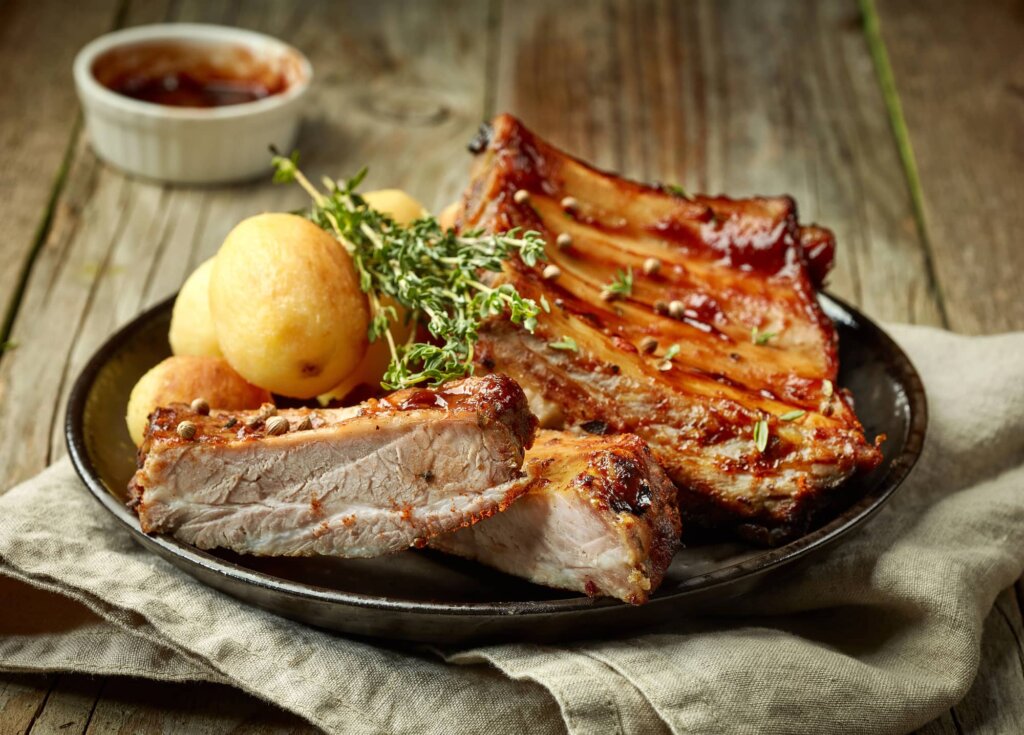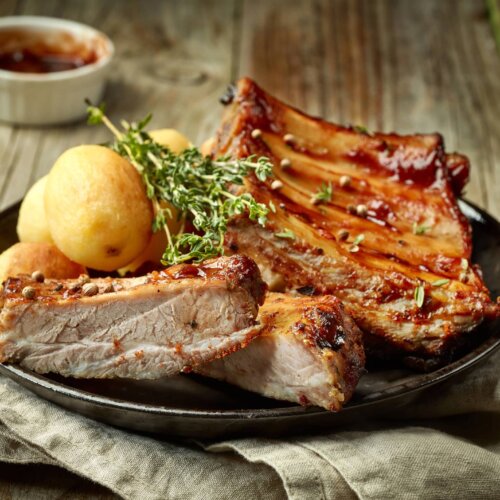
If you’re a lover of barbecue ribs, you likely have your grilling and smoking skills polished to perfection. However, learning to cook ribs inside can greatly expand your repertoire when the weather isn’t conducive to backyard enjoyment. The oven can produce ribs that are nearly as juicy and flavorful as those from the grill, especially when you use the right techniques. Pork ribs turn out great when roasted in the oven since they’re a little lean and can dry out in a smoker. Get the best possible results with our tips for making the most of pork ribs in the home kitchen.
Baby Back vs. Spare Ribs
Baby back ribs from the back and rear of the pig, as the name suggests. They’re leaner and have slightly denser meat that can be a little chewy after cooking. Spare ribs come from the lower ribs of the pig, resulting in greater fat density and a softer texture. Baby back ribs are almost always sold as entire slabs, while you can find spare ribs both attached and already separated into individual pieces.
Which Type of Ribs to Use?
It’s largely a matter of personal preference. Since the oven-roasting method doesn’t allow the meat to dry out as it cooks, pork baby back ribs can turn out perfect when cooked this way. Spare ribs also become tender and juicy when cooked in the oven tightly covered. If you choose to use spare ribs, you may want to simmer them before moving them to the oven to help cook the center of the meat and reduce a little of the fat. Avoid St. Louis-style ribs for this cooking method since they’re very fatty and may become too soft after a long roast in the oven.
How to Prepare the Ribs
Marinating the ribs is a good idea, but you don’t need a lot of flavorful seasonings for this step. A mix of vinegar and water, 1:1, is enough to soften the meat a little. Add in a teaspoon or so of Kosher salt to add some of the benefit of brining. Let the ribs soak in this liquid for about 12 hours before cooking, even if you plan to simmer them before roasting. Bring the ribs to near room temperature before starting the cooking process so they’re not cooking from a cold temperature.
Best Seasoning, Rubs, and Sauces for the Ribs
Seasoning the surface of the ribs is recommended whether you plan to add sauce or not in the last stages of cooking. Choose a barbecue rub based on your love for Kansas City, Memphis Style, Alabama, or North Carolina-style ribs. You can experiment with your own mixes of chili powder, garlic powder, black pepper, and salt as well. Throw in ingredients like cumin powder, anise seed, oregano, tamarind, and granulated coffee until you’re happy with your creation.
These ribs go great with classic tomato and brown sugar barbecue sauces. If you want to enjoy them with Carolina mustard-based sauces or white barbecue sauce, wait to apply those toppings until they’re done cooking.
Flavor Variations
Experiment with Korean or Japanese barbecue sauces as well that combine plum or hoisin sauce with soy sauce and other savory ingredients for a depth of flavor. Peanut butter sauce from Thai cuisine also makes an amazing dip or topping for roasted ribs. If you love a truly roasted BBQ crust on your ribs, try grabbing a kitchen torch and lightly crackling the surface of the sauce before you dig in.
Wrap or Boil the Ribs?
You can boil if you want to soften up chewy or tougher baby back ribs. It’s also a good trick for reducing the fat content of spare ribs and softening any cartilage or other tougher material attached to the ends. Roasting the ribs will cook them fine from raw, but simmering is a step that produces a tender texture that is unbeatable. Consider simmering the ribs in a mixture of broth and pineapple juice for the enzymatic effect that tenderizes the meat.
Wrapping with aluminum foil is highly recommended for juicy and fall-off-the-bone ribs like you’d get from a long cook on the grill. If you try to cook the ribs without covering them for a long period, you’ll find the meat is drier and tougher than you expect. Using aluminum foil traps moisture and encourages the meat’s natural juices to soften and flavor the meat. It’s the key to learning how to cook pork ribs in the oven.
Tips for the Best Pork Ribs in the Oven
If you have no aluminum foil but must enjoy oven-roasted pork ribs right away, try using a casserole dish with a lid. You can also add a liquid to the roasting pan and continue topping it up as the ribs cook so they don’t dry out.
Use a heavy-duty aluminum foil so you don’t struggle to wrap or unwrap a large slab of ribs. Thin aluminum foil could rip and let the liquids leak out during cooking.
Don’t skip the broiling stage at the end, even if you want to add sauce to the ribs after cooking. It adds flavor and color to the surface of the meat without much extra effort.
Oven Baked Pork Ribs Recipe
Ingredients
- 2 lbs of pork baby back ribs or spare ribs
- 2 cups of white or apple cider vinegar
- 2 cups of water
- 1 teaspoon of salt
- 2 tablespoons of any barbecue or pork roast rub
- Barbecue sauce (optional)
Instructions
1. Trim any silverside or membranes off of the ribs. Cut into individual sections if that’s how you prefer to cook and eat them. Soak the ribs in the mix of vinegar, water, and salt for 2 to 12 hours.
2. Remove the ribs from the marinade. Let them dry on a rack or on paper towels and come to room temperature. If you plan to parboil them, bring a large pot of broth or water to a boil and bring it down to a simmer. Simmer the ribs for 20 to 30 minutes, flipping so they’re evenly covered.
3. Preheat the oven to 275 degrees F. Set up a large roasting pan or baking sheet with a rack. Dry the surface of the ribs if they were simmered, then apply any rub or seasonings you want to use. Wrap the ribs tightly in aluminum foil, packing the ribs side by side if they’re cut into individual sections.
4. Roast the wrapped bundle of ribs for 2 to 3 hours. Begin opening the foil and checking the texture at 2 hours. When the meat is beginning to fall off of the bone, remove the aluminum foil while wearing oven mitts.
5. Turn the oven to broil. Broil the ribs for a few minutes if you want them bare, or apply a coating of barbecue sauce and then broil.
Oven Baked Pork Ribs – Nutritional Facts
Per 8 oz Cooked Rib Serving (Based on a 2,000-Calorie Daily Diet)
| Nutrient | Amount (% DV) |
|---|---|
| Calories | 450 |
| Total Fat | 32g (41%) |
| Saturated Fat | 12g (60%) |
| Cholesterol | 105mg (35%) |
| Sodium | 500mg (22%) |
| Total Carbohydrate | 2g (1%) |
| Dietary Fiber | 0g (0%) |
| Sugars | 0g |
| Protein | 34g (68%) |
| Iron | 1.6mg (9%) |
| Vitamin C | 0mg (0%) |
| Calcium | 20mg (2%) |
| Potassium | 380mg (8%) |
Conclusion
Don’t let ribs become only a summertime treat when it’s right for running the smoker or grill. Practice your oven roasting skills and you’ll soon be able to enjoy tender pork ribs at any time of year.

Oven Baked Pork Ribs
Ingredients
- 2 lbs pork baby back ribs or spare ribs
- 2 cups white or apple cider vinegar
- 2 cups water
- 1 tsp salt
- 2 tbsp any barbeque or pork roast rub
- barbeque sauce (optional)
Instructions
- Trim any silverside or membranes off of the ribs. Cut into individual sections if that’s how you prefer to cook and eat them. Soak the ribs in the mix of vinegar, water, and salt for 2 to 12 hours.
- Remove the ribs from the marinade. Let them dry on a rack or on paper towels and come to room temperature. If you plan to parboil them, bring a large pot of broth or water to a boil and bring it down to a simmer. Simmer the ribs for 20 to 30 minutes, flipping so they’re evenly covered.
- Preheat the oven to 275 degrees F. Set up a large roasting pan or baking sheet with a rack. Dry the surface of the ribs if they were simmered, then apply any rub or seasonings you want to use. Wrap the ribs tightly in aluminum foil, packing the ribs side by side if they’re cut into individual sections.
- Roast the wrapped bundle of ribs for 2 to 3 hours. Begin opening the foil and checking the texture at 2 hours. When the meat is beginning to fall off of the bone, remove the aluminum foil while wearing oven mitts.
- Turn the oven to broil. Broil the ribs for a few minutes if you want them bare, or apply a coating of barbecue sauce and then broil.

